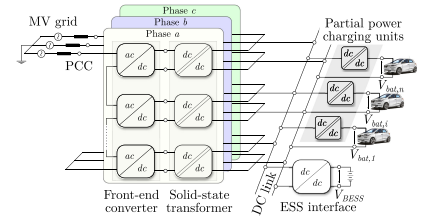An Approach towards Extreme Fast Charging Station Power Delivery for Electric Vehicles with Partial Power Processing
Objective
The main objective of the project is to eliminate redundant power conversion by making use of partial power rated dc–dc converters to charge the individual EVs.
Abstract
This article proposes an approach for realizing the power delivery scheme for an extreme fast charging (XFC) station that is meant to simultaneously charge multiple electric vehicles (EVs). A cascaded H-bridge converter is utilized to directly interface with the medium voltage grid while dual-active-bridge based soft-switched solid-state transformers are used to achieve galvanic isolation. The proposed approach eliminates redundant power conversion by making use of partial power rated dc–dc converters to charge the individual EVs. Partial power processing enables independent charging control over each EV, while processing only a fraction of the total battery charging power. Practical implementation schemes for the partial power charger unit are analyzed. A phase-shifted full-bridge converter-based charger is proposed. Design and control considerations for enabling multiple charging points are elucidated. The performance of the proposed method evaluating the results using Matlab/Simulink software. With a downscaled partial power converter that is rated to handle only 27% of the battery power, an efficiency improvement of 0.6% at full-load and 1.6% at 50% load is demonstrated.
Index Terms—Cascaded H-bridge (CHB) converter, dc fast charger, dc–dc power converters, dual active bridge (DAB), energy storage, fast charging station, partial power processing, phase-shifted full-bridge (PSFB), solid-state transformer (SST)
NOTE: Without the concern of our team, please don't submit to the college. This Abstract varies based on student requirements.
Block Diagram

Specifications
Software Configuration:
Operating System : Windows 7/8/10
Application Software : Matlab/Simulink
Hardware Configuration:
RAM : 8 GB
Processor : I3 / I5(Mostly prefer)
Learning Outcomes
- Introduction to Matlab/Simulink
- What is EISPACK & LINPACK
- How to start with MATLAB
- About Matlab language
- About tools & libraries
- Application of Matlab/Simulink
- About Matlab desktop
- Features of Matlab/Simulink
- Basics on Matlab/Simulink
- Introduction to controllers.
- Study of PWM techniques.
- Project Development Skills:
- Problem analyzing skills
- Problem solving skills
- Creativity and imaginary skills
- Programming skills
- Deployment
- Testing skills
- Debugging skills
- Project presentation skills
- Thesis writing skills


 Paper Publishing
Paper Publishing
